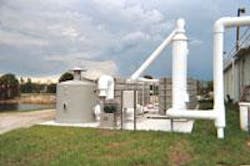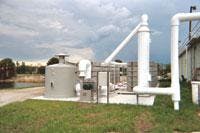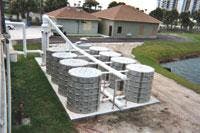Wastewater Plant Installs Biofiltration-Based System
Management of a 1/2-mgd wastewater treatment plant at Fort Pierce, FL, reports it has successfully implemented an air quality control program through installation of a customized biofiltration-based odor control system that includes an ammonia stripper and activated carbon polishing drum in addition to biofilters.
The three-stage system was designed by Biocube, of Victor, NY, whose modular biofilters remove hydrogen sulfide, the primary odor-causing compound. The company also procured an ammonia stripper and carbon drum to provide additional protection from other odor sources.
Deployment of three different technologies, in series, for the mixed-gas input was deemed the optimal method to treat for ammonia, hydrogen sulfide, and trace amounts of reduced sulfur compounds such as mercaptans and dimethyl sulfide.
"Considering our location in the fastest-growing county in the state, and in an area where ecotourism is already a prominent attraction, we wanted to take a pro-active approach to air quality, heading off any serious problems before they could develop," said Bill Blazak, Utility Director for St. Lucie County, and manager of the North Hutchinson Island Wastewater Treatment Plant.
"We already had some high-rise development within 1000 feet east of the plant, and public access park, preserve, and museum areas within 1500 east to the north, and were aware of plans for 50 new high-end residential units within 1500 feet to the west, and another 40-50 within 1500 feet to the south."
"We needed an air quality preservation solution that could not only handle our average daily flow, but also our already permitted capacity, and then be expandable if we needed to. We also needed easy setup and operation, and negligible maintenance requirements. The Biocube system met all those needs. It's now into its third month of operation, at varying daily flows, and is apparently doing what it's supposed to do, as indicated by qualitative evaluation."
Built in 1996 as a Reclaimed Water Production Facility with irrigation-quality (IQ) effluent, the McNeil Process plant eliminated former sewage treatment package plants, per the Indian River Lagoon Act, to reduce nitrogen and phosphorous loading and consequent algal blooms. Its average daily flow is currently about 0.22 mgd. About 75% of its input is residential, with another 20% from light commercial sources, and the balance from public facilities.
Plant input comes from manifolded force main collection, with 14 lift stations cycling by demand on water level, and leading to a master lift station. The latter, located about five feet from a sidewalk, was already the source of sporadic complaints. It is now covered, as is the headworks and sludge digester. Original complaints derived from the terminal manhole, located a few inches from a sidewalk running about three feet from the plant.
As feasibility and design for the solution progressed, under the direction of the county's engineering firm, LBFH Inc. of Palm City, FL, there was also concern about high concentrations of ammonia in the area of the aerobic digester, deriving from an ongoing practice of lime stabilization prior to sludge draw for land application or disposal, and resulting in complaints from as far away as 1/4 mile.
Chemical odor control was considered, but was declined by plant management and operations personnel, who characterized it as too costly and burdensome as plant flows varied. Mulch beds were ruled out as requiring space that was needed for future expansion, on a site that already had a large stormwater pond.
Biofiltration was favored as the solution, with the specification including that the selected vendor guarantee "no odor" performance, to be based on testing they would perform after their selection. Biocube was selected after an alternative was unable to inspire confidence in its ability to satisfy the performance guarantee, and was also unable to demonstrate an equivalent performance record.
Biocube's independent testing service measured hydrogen sulfide concentrations at various test sites ranging from 75-200 ppm, while ammonia was recorded at 59-771 ppm.
The new air quality system ventilates the wet well from the lift station, the plant's influent bar screen, and the digester into a common header for subsequent ammonia stripping, biofiltration, and pelletized activated carbon polishing. The 1100 cfm capacity system is designed to remove 95% of hydrogen sulfide and 99% or more of ammonia, as well as adequately handle other reduced sulfur compounds. The eight biofilters are rated at 150 cfm each, to remove up to 500 ppm hydrogen sulfide at an efficiency of 99%.
The Biocube Pentpack Biofilter consists of five patented biofiltration media trays stacked into a compact footprint. Modular design is provided to allow for use of the same technology in both larger and smaller applications.
Contaminated air, warmed and moisturized in a separate Moisture Integrator, enters the top of the Pentpack and filters down from tray to tray through bio-organic media. The tray design was developed to minimize media compaction and channeling, thereby promoting uniform air distribution and maximum contaminant removal efficiency.
Expected removal efficiencies are stated as at least 99%, even with contaminant concentrations as high as 1000 ppm. Foam-filled tray walls provide for an R30 insulation value, to allow for consistent temperature and humidity control in varying climates. The units lack moving parts, and are described as delivering 3 to 5 years of service with little or no maintenance.
Biocube, Inc. has designed, manufactured, and installed numerous cost-effective solutions for a wide variety of municipal odor control problems. For further information, visit the company's website at www.biocube.com.


